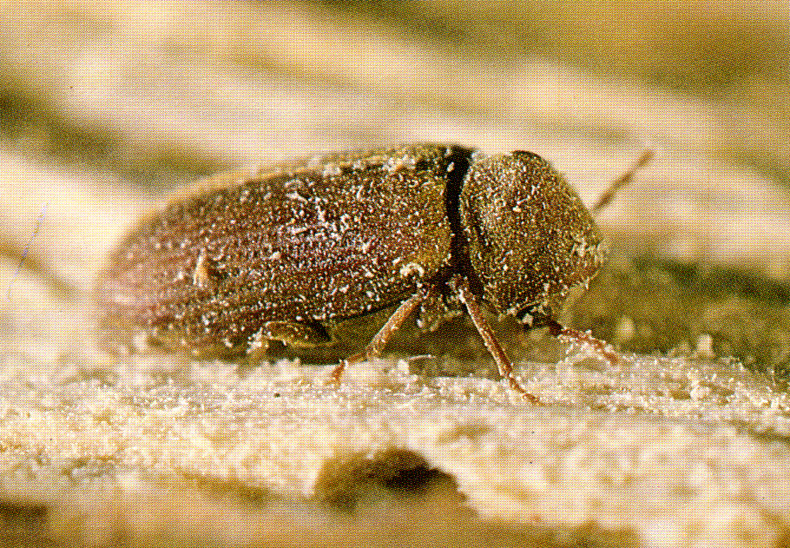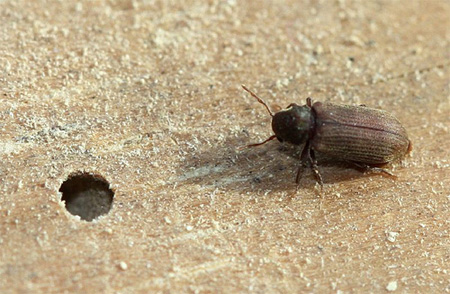Common furniture beetle
Common Furniture Beetle
The Common or Common Furniture Beetle ( Anobium punctatum ), commonly known as woodworm because of the activity of the larvae, is a type of furniture beetle ( Ptinidae ).
The adult beetles are about 2.5 to 5 millimeters long. In the wild, they are found very rarely, then mainly of dry deciduous and coniferous wood, often under ivy.
Characteristics of the beetle
The head is hidden under the pronotum (gallery, Figures 1 and 2 ). The pronotum is humped almost hood -like. The sensors are elfgliedrig, the last three limbs are greatly extended. The central members are at the inner edge as well as on the rounded outer edge (gallery, Figure 5).
Antennae and legs can be partially inserted into a cavity between the centers hips. This cavity extends through the whole of the middle chest and the bulk of the lower breast (gallery, Figure 3). The first abdominal segment is longer than the third (gallery, Figure 3).
The elytra are densely hairy and the hairs tend so that stripes are (gallery, Figure 4).
Of closely related species of the Common Furniture Beetle is safest to be separated by a genital preparation.
Figure 2: Side view
Figure 3: bottom
Fig.4: cutout batwing ceiling
Figure 5: Sensor
The life cycle of the nailing beetle
The larvae of the beetle infested rodents used in construction, so no fresh wood (dry wood pest ). From the eggs laid in wooden columns or cracks, the larvae hatch, they eat their way through the early wood. The late wood is spared and remains lamellar.
After several cycles of growth, the larva pupates adult. After his conversion ( metamorphosis ) slips a mature beetles from the doll. The exit holes in the wood are round and have a diameter of one to two millimeters. The hatched beetles looking for a Kopulationspartner. After fertilization, the furniture beetle female lays her eggs in cracks, crevices and passages of the wood. Here is then the cycle continues. The development time of larvae lasts under favorable conditions a year in unfavorable conditions for up to eight years. The hatching beetle lays its eggs like in the woods, where he grew up.
The furniture beetle is in principle capable of flight and can fly seek new nesting sites. The feeding of the larvae focuses on the sapwood. Heartwood is rarely attacked. Are the larvae active, you can see the wood flour to herausquellendem. If one black paper or something similar under the affected area, one sees in attack activity after a few days of wood flour on the paper. The time span of a few days is necessary because the larvae occasionally insert feeding breaks.
The larva of the beetle Stevenage requires a minimum wood moisture content of more than 10% and preferably cooler places - in centrally heated rooms so he rarely occurs. Critical areas are moist areas or where ground can cool / moist occur. That the infection is not bound to a maximum age of the wood. The Common Furniture Beetle will therefore usually infect centuries- old wood.
Importance as a wood -destroying insect
The Common Furniture Beetle is the most important domestic furniture beetles and at the same time spread throughout Europe. For art objects, furniture, musical instruments and utensils of wood he is as a wood -destroying insect to call in the first place. As he finds his optimum development conditions in cool, damp areas, particularly furnishings in religious buildings, such as pews, altars, wooden figures and the like are at risk. In areas with high humidity and moderate temperatures and roof structures, stables and similar objects are affected.










